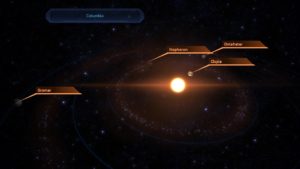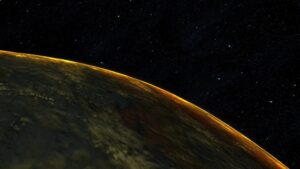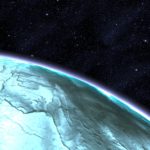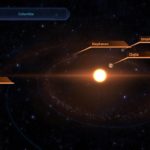System Specs:
- Stellar Mass: N/A Sol Masses
- Stellar Class: N/A
- Luminosity: N/A Sol
- Planets: 4
- Moons: 0
- Asteroid Belts: 2
- Asteroids: 0
- Objects: 0

–
Planets Directory:
- Clojiia
- asteroid belt
- Nepheron
- Ontaheter
- asteroid belt
- Gromar
–
Clojiia:

- Orbital Distance: N/A AU
- Orbital Period: 0.3 Earth-years
- Keplerian Ratio: N/A
- Radius: 7,074 km
- Day Length: 47.6 Earth-hours
- Atmospheric Pressure: 18.33 atm
- Surface Temp: 312 °C
- Surface Gravity: 1.1 g
- Mass: 1.343 Earth-masses
Clojiia is a “hothouse” terrestrial world with a dense atmosphere of nitrogen and sulfur dioxide. The surface is scorching hot, and mainly composed of iron with deposits of gold.
The core of Clojiia is very hot and tectonically active. Volcanic eruptions are common, and the outgassing continues to add to the density of the atmosphere. The largest active volcano has a caldera nearly 100 kilometers in diameter, and its basalt floods have covered an area roughly equivalent to the size of the Earth continent of Australia.
–
Nepheron:

- Orbital Distance: N/A AU
- Orbital Period: 0.8 Earth-years
- Keplerian Ratio: N/A
- Radius: 6,865 km
- Day Length: 56.2 Earth-hours
- Atmospheric Pressure: 0.73 atm
- Surface Temp: 37 °C
- Surface Gravity: 0.88 g
- Mass: 1.012 Earth-masses
- Satellites: 1
Nepheron is a barren, volcanic terrestrial world with an atmosphere of carbon dioxide and krypton. Its surface is mainly composed of sodium with deposits of magnesium.
Aside from displays of geologic beauty (including many spectacular volcanoes), this barren world is of little interest. Entries relating to Nepheron in the astronomical database are sparse.
–
Ontaheter:

- Orbital Distance: N/A AU
- Orbital Period: 5.2 Earth-years
- Keplerian Ratio: N/A
- Radius: 3,718 km
- Day Length: 56.3 Earth-hours
- Atmospheric Pressure: 0.06 atm
- Surface Temp: −124 °C
- Surface Gravity: _ 0.66 g
- Mass: N/A Earth-masses
Ontaheter is an unusually large ice world, with a core of silicate rock and light metals, and a trace atmosphere of krypton and xenon. The crust is mainly composed of water ice. Ontaheter’s ice sheets show obvious signs of large scale fracture and refreezing, centered on a massive crater near the south pole.
A recent extranet meme suggests that a Prothean ship crashed through the crust of the planet before the collapse of their empire, and might still be recovered from the planetary core. This is purportedly the source of the planet’s unusually high mass. Careful mapping of the planet’s gravity field by orbiting satellites have proved that the planetary core is entirely normal.
–
Gromar:

- Orbital Distance: N/A AU
- Orbital Period: 115.6 Earth-years
- Keplerian Ratio: N/A
- Radius: 4,911 km
- Day Length: 30.3 Earth-hours
- Atmospheric Pressure: 0.13 atm
- Surface Temp: −218 °C
- Surface Gravity: 0.28 g
- Mass: 0.165 Earth-masses
Gromar is a rocky, terrestrial world with a trace atmosphere of krypton and xenon. The frozen surface is mainly composed of copper with deposits of calcium. Prior to the Alliance‘s expansion into the Voyage Cluster [sic], Gromar hosted half of a turian interferometric telescope array. Connected with similar telescope in the Attican Beta cluster by an expensive chain of FTL comm buoys, the two functioned as a virtual “lens” with an effective aperture equal to the thousands of light years between them. The turians used this to map the Terminus Systems with great accuracy.
Survey Text
“Scans of the planet Gromar revealed a derelict space station in late stages of orbital decay. A small team was able to recover some items of interest. Among them, a League of One medallion.”
–
video






